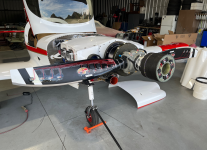Laird
Well Known Member
Recently spied at an open hangar in Socal.
Great example of strain gauging a propeller to do vibe testing. Note the large black hub forward of the propeller. It's the data collection and transmitter unit. Transmits sensor data to a laptop in the passenger seat.
Great to see Hartzell go to this level of testing.
Laird
Great example of strain gauging a propeller to do vibe testing. Note the large black hub forward of the propeller. It's the data collection and transmitter unit. Transmits sensor data to a laptop in the passenger seat.
Great to see Hartzell go to this level of testing.
Laird





